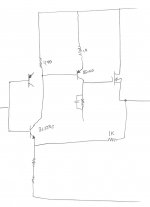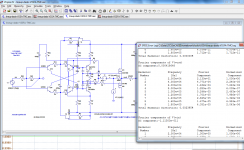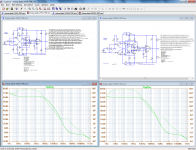Thanks Esperado, great work.
There's no VFA with the same parts count to come close to VSSA. The name tells everything Very Simple Symmetrical Amplifier and it is best sounding simple amplifier of them all.
Regards L.C.
No one is contesting the genius of your design. I salute you.
We started this thread as a learning tool since it seems to me a large part of the DIY community are not familiar with this topology.
The suggestion is to take a conventional, classic CFA and then evolve it to a high performance design - along the way exploring some of the unique properties of the topology.
No one is dissing VSSA, and no need to diss VFA either.
If VSSA is not classic CFA I really don't know what it is??? 😕
Diamond buffer sounds worse than single modulated part in the input stage, because it has the same problem as LTP, the signal is subtracted through different parts (input transistor and feedback transistor), so each part is playing different role and there you miss coherence of the signal. Loads of unwanted math functions are inserted to the system without any reason.
LTP and diamond buffer in power amps should be avoided miles around!
Try telling that to ADI, TI and everone else doing CFA IC's . . .
LC's circuit is similar topology to the one I put up from 1980. The difference is that the input runs single-ended with feedback to each emitter thru seperate resistors.

I preferred the all push-pull from input to output and one resistor to both emitters at same time. Only one part less (one R fb) but all stages compl/push-pull.
THx-RNMarsh

I preferred the all push-pull from input to output and one resistor to both emitters at same time. Only one part less (one R fb) but all stages compl/push-pull.
THx-RNMarsh
Could we keep the VSSA marketing blurb to the vendors bazaar where it belongs ?
It is there, no worries. 😎
Yours blurb is only until you will hear what this little monster is capable of.

Try telling that to ADI, TI and everone else doing CFA IC's . . .
Will you make semiconductor die's tolerances here on PCB + layout??? 😕
Will you make semiconductor die's tolerances here on PCB + layout??? 😕
Follow gk7's advice.
Thanks Esperado, great work.
There's no VFA with the same parts count to come close to VSSA. The name tells everything Very Simple Symmetrical Amplifier and it is best sounding simple amplifier of them all.
Regards L.C.
Great work , yes ; he basicaly set the VFA version such that
it has 15 x less loop gain and then declare that the CFA has
better THD numbers....
Curious is that you once deemed the simulators as not precise
but you are ready to be agree with a flawed comparison using
sims if it suit your agenda.....
This thread is about certain people parading their designs 'brilliance'. I guess my earlier sarcasm completely escaped the intended recipient who is now on my ignore list.
😀
😀
I tried my best with those sims. Everybody with minimum of knowledge knows it is impossible to make an exact mirror of a CFA to VFA (and vice versa). I tried with the few time i had (i said quick'n dirty) to bring the closest version i could, the one with the best possible results for VFA and not the contrary as i was accused (if you set the input gain equal, you cannot keep the VAS close enough, in current/gain/bandwidth and it is 10 time worse).
The two circuits can be brought quite close in caracteristics
and linearity will then be similar.
The difference will be only when trying to improve the designs ,
then the VFA version will have more room for improvement
because current mirrors can be straightfully added while
for the CFA there wont be such a simple possibility that would
be as simple to implement.
This thread is about certain people parading their designs 'brilliance'.
And the density of crap flying around is incredibly high. Your papaya is larger than my banana, that is.
Nobody cares to understand that CFA's for audio are anything but "CFA's" in the classic (ADI, TI, etc...) sense. And that's because the closed loop gains for audio are rather high, therefore the effect ("compensating") of the feedback resistor on the open loop gain and loop gain is limited to 2-5%, essentially 1/(1+CLG).
This thread's topic is in fact about the input stage topology, diamond buffer vs. LTP. That can be discussed, in terms of linearity, sensitivity to matching, current capability, noise, bandwidth, gain, etc... but I certainly doubt there is any reason to always choose one over the other.
Esperado: I'm fine, thank you very much for asking.
Hi Guys
Bonsai, in your CFA Study it is not clear if both the shunt comp and Alex comp are in play or just Alex comp. Could you clarify?
Also, I know Alexander has done a great deal to promote CFA, but calling that cap "Alexander comp" disregards the fact that such compensation has been used in amplifier circuits before 1980. I believe it first appeared in the late sixties. Call it what you will, though.
Have fun
Kevin O'Connor
Bonsai, in your CFA Study it is not clear if both the shunt comp and Alex comp are in play or just Alex comp. Could you clarify?
Also, I know Alexander has done a great deal to promote CFA, but calling that cap "Alexander comp" disregards the fact that such compensation has been used in amplifier circuits before 1980. I believe it first appeared in the late sixties. Call it what you will, though.
Have fun
Kevin O'Connor
I agree completely: the performances of an amplifier will ultimately boil down to the merit figure of the output devices and the skills of its designer.That can be discussed, in terms of linearity, sensitivity to matching, current capability, noise, bandwidth, gain, etc... but I certainly doubt there is any reason to always choose one over the other..
Here is a fairer comparison between the two topologies, with the key parameters like collector currents unchanged, and the main components rearranged in a VFB style.
The only important difference is the addition of the two VFB transistors.
The THD is practically unchanged, as is the OL bandwidth.
Ironically enough, the so called CFB has a marginally higher loop gain (65.7dB against 64.6dB) and a marginally lower bandwidth (9.1KHz against 9.9KHz)).
Can you believe what is indicated on the tin?
It is simply that the feedback networks have such a low value, on the same order that 1/gm, that in reality the CFB behaves as a more perfect VFB amp than the "true" VFB. Funny isn't it? It is actually a VFB in disguise.
This means that there is apparently no good reason for opting for the so-called VFB topology, since the performances are essentially identical, and that the VFB requires additional transistors.
That is of course a superficial view: in the CFB version, any mismatch in the feedback networks will translate in a huge increase in THD, which is not the case in the CFB, because there is a single network, and other components are inside the feedback loop and less sensitive.
Attachments
And the density of crap flying around is incredibly high. Your papaya is larger than my banana, that is.
Nobody cares to understand that CFA's for audio are anything but "CFA's" in the classic (ADI, TI, etc...) sense. And that's because the closed loop gains for audio are rather high, therefore the effect ("compensating") of the feedback resistor on the open loop gain and loop gain is limited to 2-5%, essentially 1/(1+CLG).
This thread's topic is in fact about the input stage topology, diamond buffer vs. LTP. That can be discussed, in terms of linearity, sensitivity to matching, current capability, noise, bandwidth, gain, etc... but I certainly doubt there is any reason to always choose one over the other.
Esperado: I'm fine, thank you very much for asking.
My thoughts exactly.
Hi Guys
Bonsai, in your CFA Study it is not clear if both the shunt comp and Alex comp are in play or just Alex comp. Could you clarify?
Also, I know Alexander has done a great deal to promote CFA, but calling that cap "Alexander comp" disregards the fact that such compensation has been used in amplifier circuits before 1980. I believe it first appeared in the late sixties. Call it what you will, though.
Have fun
Kevin O'Connor
It's Alexander comp in the study circuit.
I am ok to call it something else, but I think he was the first guy to publish about it specifically related to power amplifiers.
I am open to correction.
Elvee can you upload your .asc files - I cannot read them as is.
Attachments
Nice one, Elvee. But, if you want to be fair, don't kill the VSSA to begin a comparison: use my VSSA CFA sim, conform to L.C. schematic:Here is a fairer comparison between the two topologies, .
http://www.diyaudio.com/forums/solid-state/225747-vssa-lateral-mosfet-amplifier-6.html#post3314786
This one is not at all. Too easy to kill the bandwidth of a CFA to make-it measure like a VFA 🙂
This will be my last contribution to this thread.
Best wishes to all my friends in this forum.
Last edited:
- Home
- Amplifiers
- Solid State
- CFA Topology Audio Amplifiers



